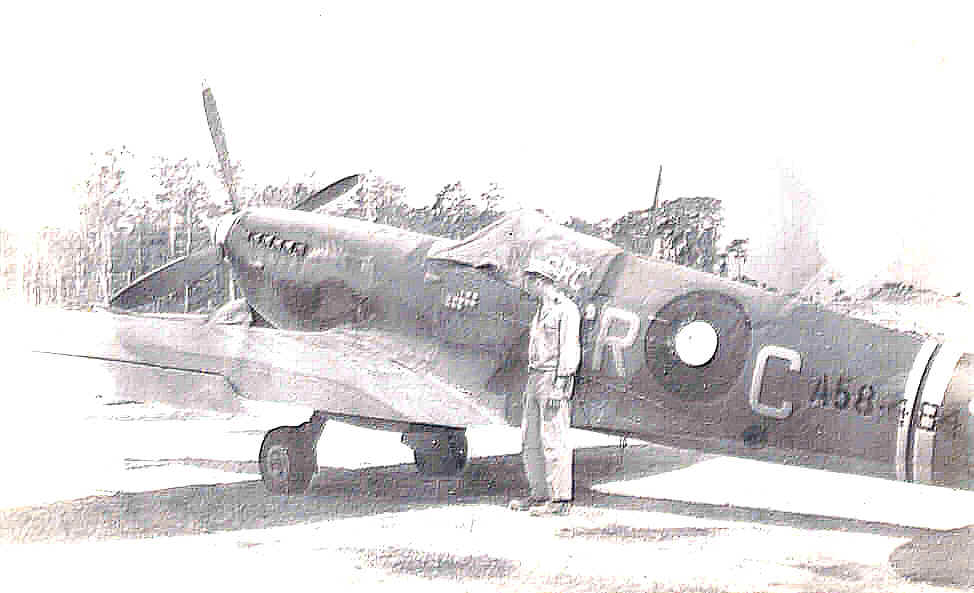
Image du Jours -- World War II
About this Spitfire - WWII #1 of 23.

(Image from Heckman-Cashion Collection)
But first, about the source of the first five images --
A man died February 18, 1946, leaving a three-year-old son, a grieving widow, and the remnants of a common man's life. After his death, many of his things were disposed of. Thirty-four years later, his widow started arranging her possessions before moving to a nursing home in Cincinnati. It was then she remembered her husband’s trunk in the attic.
She had it brought down, went through it, shed a few tears, and said a sad goodbye to the last possessions of her husband. She and he had been together for such a short time.
He had enlisted in the Seabees in June 1942, and in August, he departed for instruction in Davisville, RI. After being trained on many pieces of construction equipment, he left for the South Pacific in January 1943.
He served on Morotai, an island northwest of New Guinea, and was discharged ill from the Seabee's 84th Construction Battalion, Company A, Platoon 1, on December 2, 1945. He lived less than 100 days afterward.
So on February 26, 1980, shortly after the 34th anniversary of his death, surrounded by letters and wartime memorabilia, the widow picked up the phone in Cincinnati and called the local Navy recruiting office – "Does anyone there want some old war pictures?" Personnel Specialist Colette Cashion was the recruiter and took the call. The chief of the office did not know what to do with the call so Cashion said she would take care of it. She asked the widow if she would like to have the photos sent to a military historian who collected and preserved such things. The lady thought that was a good idea. After I received the photos, I called the lady to let her know that I had them. We talked quite some time. There were no more photos and no negatives. She was alert and happily living in a single room at the nursing home. I talked to her son and confirmed that he had no artifacts from the period. He said that I already knew more about his dad's experiences than he did. The photo shown is one of the twelve or so photos of this collection and it is the most interesting. What is unique about this photo of a Spitfire is the amount of information in the photo. (There was no data with the photos.)I think the photo was made on Morotai – those are eucalyptus trees in the background and crushed coral on the ground.
The Spitfire was a British aircraft but those are not British RAF roundels on the fuselage but those of the RAAF -- Royal Australian Air Force. The photo shows "kill" flags under the edge of the cockpit, but they are arranged in a strange manner. There are 11 white figures and they do not all look alike. They look like white rectangles with the rising sun in the center, so this pilot has shot down 11 Japanese aircraft. The first one is a half-flag so the pilot may be sharing a kill with someone. Why are they arranged that way? Because, hardly seen in this scanned image are other kill marks above the white rectangles. These are little white "L"s arranged in a strange way. They outline crosses. The pilot of this aircraft had shot down eleven Japanese aircraft and at least five German aircraft – maybe more crosses were under the cockpit cover. Who was this guy?! Well... it is written on the aircraft and the canopy cover! "CRC!" This late model Spitfire was flown by Australia's leading ace, Group Captain (See the bands on the fuselage?) Clive R. Caldwell. "C.R.C." destroyed 30 combat aircraft, earning a Distinguished Service Order and a Distinguished Flying Cross. He shot down 16 German aircraft in North Africa, as well as four Italian fighters (shared two), and he was the leading allied fighter pilot in the Desert War. He shot down the best German single-engine fighters, as well as twin-engine fighter bombers.And interestingly, he did this while flying sundry models of American Curtis P-40s, an airplane that was supposed to have been outclassed early in the war. On one morning he shot down five German dive bombers and an Italian fighter!
He finished his combat career shooting down Japanese aircraft in the South Pacific. He is also credited with six probables and 15 damaged.The Australian fighter pilots were left "down south" as the war in the Pacific moved farther north. A lot of these pilots did not appreciate being left behind.
He was promoted and transferred back to Australia where he served in a higher position. He left the RAAF in 1946. He had flown out of Morotai starting in February 1945 and that was where the Seabee photographer was until December 1945. I do not think the Seabee photographer had any idea about this aircraft or its pilot when he took the photo. Judging from his other photos, he was just taking grab shots of whatever he saw. He may not have ever known about Caldwell – but this Seabee photographer was there in the South Pacific – doing his part. And he was one of many casualties.Ken Cashion